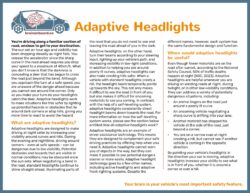Driver Assistance Technology
Many safety features are designed to assist drivers in routine driving tasks such as monitoring the road environment, safely moderating vehicle speed, and maintaining proper lane positioning. Safety features that support driver functions are a category of safety features called driver assistance technology.
There are clear ways in which all safety features assist drivers. For example, although brake assist is classified as an active safety feature, it does help the driver to brake more effectively. Similarly, traction control – also classified as an active safety feature – helps drivers to make the most use of all the available traction. The difference between active safety features and driver assistance technology lies in the situations that they are meant to address: active safety features address sudden situations that could pose an immediate threat to drivers and vehicle occupants. Driver assistance features address everyday situations, like driving in low-light conditions or judging the rate at which traffic is slowing down on the roadway ahead.
Driver assistance technology cannot replace a good driver, or be relied upon to pick up the slack for inattentive driving. However, by making certain driving tasks less strenuous, they can improve road safety by making individual drivers safer.
To find out more about driver assistance technologies, how they work, and what they do, continue clicking through the safety features on the left side menu. Or, search specific features to learn more about them.

